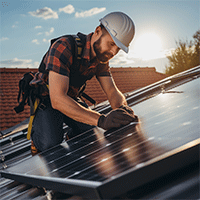Cost of solar panels in Illinois
How much is it to go solar in 2023?

The average cost to install solar panels is $20,476 in Illinois before factoring in the federal investment tax credit (ITC). After the ITC, the upfront cost drops to $14,333.
Going solar in the Prarie State is about 14% cheaper than the national average. Compared with other states, the average cost per kilowatt is a little higher than in some regions. Illinois tax incentives can make paying for solar easier, however.
Key insights
- The average cost per watt for solar energy systems in Illinois is $2.73.
- If you pay fully upfront, the average break-even period is 12 years.
- Over 25 years, the estimated average net savings for going solar in Illinois is around $16,585.
How much do solar panels cost in Illinois?
Installing residential solar panels in Illinois can cost between $10,000 to $30,000 or more, though individual costs vary significantly. On the high end, Joseph in Lebanon paid $95,000 for a system.
Of course, how big your system should be depends on your energy needs. One way to determine the system size you need is to divide your monthly energy use in kilowatt-hours (kWh) by the average daily sunlight hours. This gives you an idea of how much power you need to generate each day.
» WATT’S THE DIFFERENCE? kW vs. kWh
Average cost by system size in Illinois
| 5 kW | 6 kW | 7 kW | 8 kW | 9 kW | 10 kW | 11 kW | |
|---|---|---|---|---|---|---|---|
| After federal tax credits | $9,555 | $11,466 | $13,377 | $15,288 | $17,199 | $19,110 | $21,021 |
| Before federal tax credits | $13,650 | $16,380 | $19,110 | $21,840 | $24,570 | $27,300 | $30,030 |
| Approximate home size in square feet | 1,200 | 1,400 | 1,600 | 1,800 | 2,000 | 2,200 | 2,400 |
Are solar panels worth it in Illinois?
Many solar customers in Illinois tell us it’s worth it for the cost savings. Ronald in Chicago cut his electricity bill in half, Colleen in Chicago saves $30 to $50 each month, and Kathy in New Lenox “loves getting this $14 ComEd bill.”
“Going solar has saved my life,” another solar customer, Valerie in Chicago, told us. “My last bill went from 200-and-some dollars to $40.”
Others we’ve talked to in Illinois like the consistency of knowing what their bills will be each month. “So far, everything’s working fine and my bill always stays the same, $76 a month all year round,” James in Kingston said. “Going solar is the best thing I ever did.”
Going solar has saved my life. My last bill went from 200-and-some dollars to $40.”
“You will not regret it,” Scott in Crystal Lake said. “We're saving hundreds and hundreds of dollars a month right now.”
People also like that they can lock in the cost of their power for the next 20 to 30 years. “When power prices go up in the future I won't have to worry about it because my home is powered by the sun!” Jake in Germantown Hills said.
However, not everybody in Illinois gets the same return on their solar investment. Thomas in Dolton said he’s paying “almost the same as it was when I count in the monthly fee that I pay and what the bill is. But one of the things that I'm sort of interested in is the environment. Later on, it'll be a little bit more cost-benefit for me.”
Some Illinoisans say going solar is worth it primarily for the environmental benefits, like Wardell in Chicago: “We need to get ahead of climate change and clean energy is a great way to start.”
Cost factors of going solar in Illinois
The cost of a solar energy system is not a one-size-fits-all situation. The price tag depends on many things, including how big of a system you're getting, the system’s efficiency, add-ons and the quality of your roof.
Equipment costs
Solar panel efficiency can be a major equipment cost factor. Efficiency is how well a panel can turn sunlight into energy. More efficient panels are more expensive, but buying higher-efficiency panels also means you need to buy fewer panels overall.
» MORE: How much do solar batteries cost?
Some optional equipment that can increase the cost of your system include solar batteries and solar monitoring systems. Batteries can cost $7,000 or more each, and monitoring systems can run $80 to $400.
Labor and permit costs
When figuring out how much your solar energy system will cost, don’t forget to add in labor costs and the costs for local permits and fees. Many solar companies include these fees in the overall price of the system, but check your contract to be sure.
Solar panels typically last 25 years.
Condition of your roof
You can expect your solar panels to last 25 to 30 years, so your roof needs to last just as long. Before diving into getting solar, ensure your roof is inspected, repaired or replaced. This can save you the added costs of removing and reinstalling the system during a roof renovation.
Kim in Roscoe had to have panels removed to have a new roof installed and ended up paying “$170 per panel, which is over $5,000.”
» MORE: Should you replace your roof before going solar?
How you pay
You've got options when it comes to paying for your solar energy system. You can pay upfront to buy your solar setup outright. If you don’t have the full amount readily available, you can secure a solar loan and make monthly payments. Like any other loan, solar loans are paid back with interest.
Another option is leasing a solar energy system, which lets you pay a fixed monthly amount with little to no down payment. When you lease, the leasing company owns the panels. So, while you might save on your electricity bills, you'll miss out on benefits like potential tax credits or increased property value.
Sahil in North Aurora put it this way: “You're going to save 50 bucks a month from your electric bill, but the rental of the panels was 20 bucks a month. So, the savings is really going to be $30 overall.”
Another option is a power purchase agreement. You make an agreement with a solar company, and it brings the solar panels to your roof. It foots the initial bill, and you agree to buy the electricity the panels produce at a fixed rate, usually lower than what you'd pay to your local utility company.
Solar incentives, tax credits and rebates in Illinois
The federal solar investment tax credit (ITC) can save you the most out of any incentive for going solar in Illinois. Residents who install solar panel systems by the end of 2032 can deduct 30% of the system’s total cost from that year’s federal taxes. The credit includes the cost of equipment, labor and permits. Eventually, this credit drops to 26% in 2033 and 22% in 2034.
The average federal solar investment tax credit value in Illinois is $6,143 in 2023.
Illinois also offers tax incentives to help with the cost of buying solar for your home.
» EXPLORE: Illinois solar incentives
Compare solar installation companies in Illinois
Compare popular solar companies available in Illinois below. Read our guide to finding the best solar companies for more.
| SunPower | Sunrun | Palmetto Solar | |||||
|---|---|---|---|---|---|---|---|
| Primary | SunPower | Read reviews | Customer Ratings 4.3 | Free quote | Payment options
Cash, loan, lease
| Warranty
10 to 25 years
| |
| Primary |  | Sunrun | Read reviews | Customer Ratings 4.1 | Free quote | Payment options
Cash, loan, lease
| Warranty
25 years
|
| Primary | Palmetto Solar | Read reviews | Customer Ratings 3.7 | Free quote | Payment options
Cash, lease, loan or PPA
| Warranty
25 years (product and performance)
|
FAQ
How are solar costs trending in Illinois?
According to the Solar Energy Industries Association, the cost to go solar in Illinois has fallen 43% over the last 10 years.
» SOLAR PANELS: Lease vs. buy
How much can I save with solar panels?
Illinois residents who go solar average $16,585 in savings over 25 years. It’s important to remember that solar panels may not completely eliminate your monthly power bill. You’ll still be saving a lot of money over time, though, and you can expect to offset your electricity bill by 75% to 102%.
How does net metering work in Illinois?
Net metering is when your solar energy system produces more energy than you need, which lets you sell it to your local electric company. Payment usually comes in the form of a credit on your bill. In Illinois, electric companies either pay customers the same amount they charge for energy or offer solar residents a set rate.
» COMPARE: Best solar monitoring systems
How many solar panels do I need for my house?
The number of solar panels you should purchase depends on how much sunlight your home gets and how much energy your home uses. In Illinois, the average monthly energy consumption in 2021 was 728 kWh, according to the U.S. Energy Information Administration. A 2,000-square-foot-home on average needs about 19 solar panels to fully power it.
Can I get free solar panels in Illinois?
No programs in Illinois offer free solar panels, but you can lease or enter a PPA with little to no upfront costs.
Bottom line
Getting solar in Illinois is a smart and eco-friendly move. Going solar is cheaper here than in many other states, and Illinois offers tax incentives to help make paying for your system easier. When choosing a system, be sure to factor in equipment, labor, permit and roof repair or replacement costs to ensure you can afford solar before signing a contract.
» STILL NOT SURE? Solar pros and cons
Solar costs: Illinois vs. nearby states
| Upfront cost* | ITC value (30%) | Typical system size | Average cost per watt | Payback period** | Estimated net savings | |
|---|---|---|---|---|---|---|
| Illinois | $20,476 | $6,143 | 7.5 kW | $2.73 | 12 years | $16,585 |
| Michigan | $19,670 | $5,901 | 7 kW | $2.81 | 10 years | $23,652 |
| Ohio | $23,040 | $6,912 | 9.5 kW | $2.56 | 12 years | $19,272 |
| Wisconsin | $18,200 | $5,460 | 7 kW | $2.60 | 10 years | $21,005 |
Article sources
- EcoWatch, “ Solar Panel Cost in Illinois .” Accessed Aug. 31, 2023.
- Office of Energy Efficiency & Renewable Energy, “ Homeowner’s Guide to the Federal Tax Credit for Solar Photovoltaics .” Accessed Aug. 31, 2023.
- Solar Energy Industries Association, “ Solar State By State .” Accessed Aug. 31, 2023.
- DSIRE, “ Illinois Solar Programs .” Accessed Aug. 31, 2023.
- U.S. Energy Information Administration, “ 2021 Average Monthly Bill- Residential .” Accessed Aug. 31, 2023.
- EnergySage, “ Illinois solar panels: local pricing and installation data .” Accessed Aug. 31, 2023.
- Illinois Attorney General, “ Net Metering and Interconnection .” Accessed Aug. 31, 2023.
You’re signed up
We’ll start sending you the news you need delivered straight to you. We value your privacy. Unsubscribe easily.
